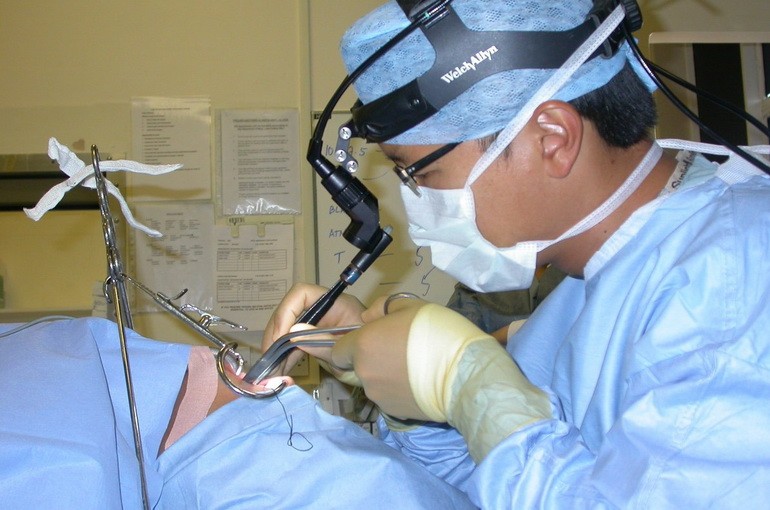
When you need to remove almonds. Tonasilectomy views. Features of the postoperative period.
The content of the article
- Laser and radio wave tonsillectomy: indications
- Video: tonsillectomy by radio frequency ablation
- Tonsillectomy bilateral: operation
- Video: Tonsillectomy. Types of operation
- Tonsillectomy and postoperative period
- How much is the temperature after tonsillectomy?
- How much throat hurts after tonsillectomy?
- Bleeding after tonsiltectomy
- Video: What will happen if you remove the glands?
- Complications after tonsilctomy
- The consequences of tonsillectomy. Is it possible after tonsillectomy?
- Restoration after tonsilectomy - rehabilitation. Meals after tonsilectomy: diet
- Tonsillectomy under general anesthesia: reviews
- Video: Laser Ablation of Sky Almonds
Tonsillectomy is an operation that is carried out often from very long. The first references to the excision of GRAND are mentioned in the ancient Greek and ancient Roman sources, which are already under 3,000 years.
Today, the Glands have been removed from each 8 inhabitant of the planet Earth, and through the operation two thirds of these people passed in childhood. Why a similar type of surgical intervention "put on flow"? How much is it necessary? What are the testimony for tonsilctomy, what will happen after it? It is worth trying to find answers to these questions.
Laser and radio wave tonsillectomy: indications
Tonsillectomy - a medical term with Latin and Greek origin. Tonsilla (lat.) Means "almond", and ἐκτομή (Greek) - "Delete".
This is an operation, during which the surgeon is one of the practitioners of methods removes the patient of the Glad (sky almonds) along with the connecting capsule.

Tonsillectomy.
Modern medicine knows several methods of removal of GRAND:
- scalpel, scissors and wire loop
- electro-generation
- cryodestruction
- CO2 laser.
- ultrasound
- radio frequency ablation
Chronic tonsillitis - the disease is rather heavy, unpleasant, sometimes it is difficult to cope with it. And there is no other way out, rather than remove the body, which is a constant source of infection.
IMPORTANT: Previously, tonsillectomy did it clarificate. Moreover, not only patients with chronic inflammation of almonds, but also for prevention. The operation was considered light and little traumatic, and the gland - by the runtime organ. Today, they became an obvious role in the formation of human immunity, so they are sent to the operation only in extreme cases, if there are clear indications.
These include:
- Chronic tonsillitis with frequent relapses (frequent angina). This is considered to be tonsillitis, which exacerbates more often than 4 times a year, within 2-3 years.
- Chronic tonsillitis, which has passed into a decompensated form. With this, the glands not only are inflamed, they have a number of irreversible destructive changes. Infection with them applies to nearby organs. The focus of infection is growing.
- There are complications of the disease in the form of allergyizing the body, cardiovascular pathologies, diseases of the kidneys, joints, endocrine glands.
- The almonds grow to such an extent that they interfere with breathe (apnea, respiratory stops in a dream) or swallow.
- Parapezillar abscess, phlegmon, other purulent complications arose.
- The conservative treatment measures were taken by the conservative treatment of chronic tonsillitis, but they did not give results.
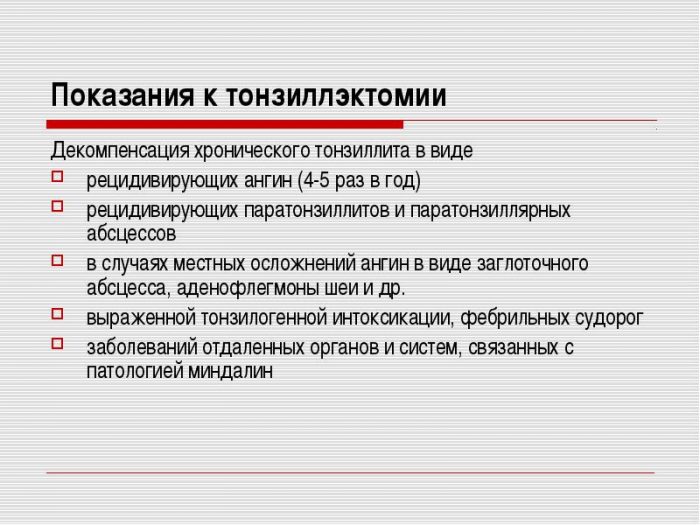
Indications for tonsillectomy.
Important: It is advisable to carry out tonsillectomy during the remission when the almonds are relatively calm. In the presence of purulent complications or in other cases of operation during the exacerbation period, high doses of antibacterial drugs are prescribed to the patient.
But there are people who are tonsillectomy, conducted by any of the methods, is categorically contraindicated. These are patients with chronic tonsillitis C:
- leukemia, other serious blood diseases
- anomalies of blood vessels
- lung tuberculosis in open form
- diseases of the heart, kidneys, liver, lungs, in which irreversible changes in these organs occur (decompensation stage)
- heavy forms of neuropsychiatric pathologies
- severe form of diabetes
It is not temporarily carried out, it is transferred to a more favorable tonsilectomy when:
- ORVI and flu
- exacerbation of chronic diseases identified in patient
- ketonuria in Diabetikov
- caries teeth
- menses
IMPORTANT: Before surgery, the Laura, therapist, specialist doctors, as needed, and also gives the clinic and biochemistry, coagulogram, urine clinic, visits the patient with chronic tonsillitis.
Laser tonsillectomy
Instead of scalpel or scissors in LOR-Practica, using lasers (diode or carbon dioxide) as a surgical instrument.
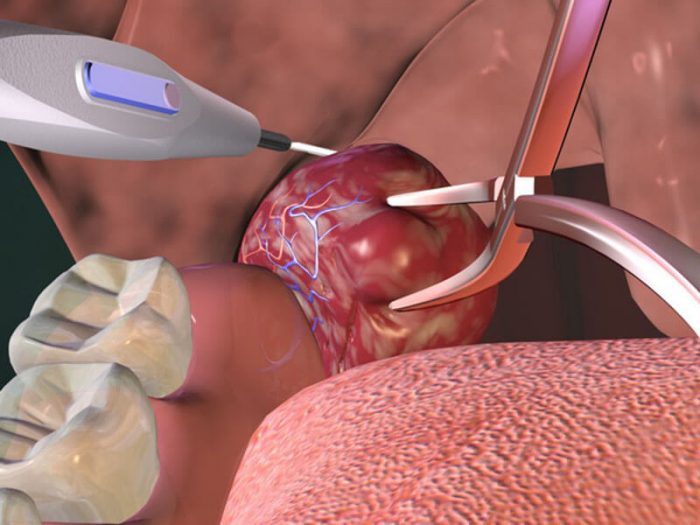
Removal by almonds with a laser.
Removal GRAND Laser is considered gentle by the laser beam at the same time:
- destroys pathological tissues
- coagulables ("burns" small blood vessels, so that the risk of infection of the wound or the discovery of strong bleeding is reduced)
For laser tonsillectomy, the patient has no need to hospitalize the patient. Perform an outpatient operation. Patient makes local anesthesia.
Recovery after intervention, as a rule, happens quickly.
Radio wave tonsillectomy
Another modern removal method is radio wave.
Human almonds by 70-90% consist of water. The electrode - the scalpel gives them a radio signal that evaporates this water. Thus, pathological tissues are dissected.
Wherein:
- nearby fabrics and organs are not damaged
- thermal impact on the fabric minimal
- blood vessels and nerve endings are coagulated, thanks to which the method is almost bloodless, soreness after the intervention is minimal
- the scar after radio wave tonsilectomy is not formed
Conducting operation with a radio wave method is possible both under general anesthesia and local anesthesia.
VIDEO: Tonsillectomy by radio frequency ablation
Tonsillectomy bilateral: operation
Despite the existence of modern little traumatic methods, the removal of a sound with a scalpel or scissors is practiced so far.
- Before the operation examine the blood of the patient. Since the tonsilectomy of the scalpel is not a bloodless method, it is necessary to make sure that there are no problems with blood coagulation. Make a coagulogram.
- Next, are determined with the method of anesthetic. Adults and children from 12 years old tonsillectomy double scalpel is usually carried out under local anesthesia. Children elect the anesthesia general, firstly, because painful sensations during the operation - a large stress for them, secondly, they will not be able to stop motionless. Before using this or that type of anesthesia, they check whether the patient has allergies to him.
- During operation, the patient sits or lies. The manipulations begin as actions of anesthesia. When local - in 5-10 minutes.
- Sky almonds are delayed with clamps and cut off with a scalpel, scissors and a special loop.
To the bleeding vessels, after cutting, the almonds are applied cotton balls, they are tightly pressed. As a rule, this is enough to stop the bleeding. Those vessels, bleeding from which abundant, tied up with silk thread. - When blood stopped, the operation is considered complete.
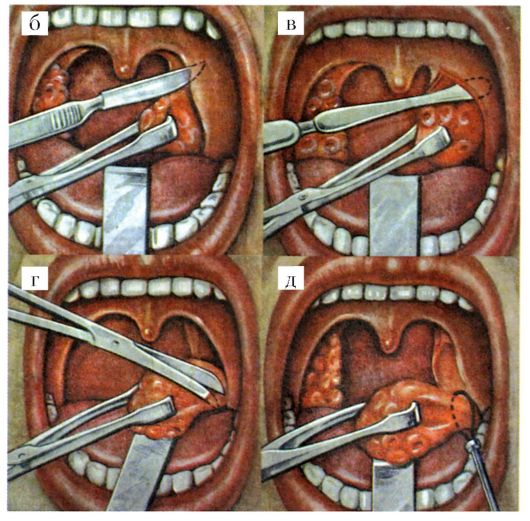
Removal of the cry the scalpel.
Important: the duration of tonsillectomy scalpel - 30 minutes - 1 hour.
VIDEO: Tonsillectomy. Types of operation
Tonsillectomy and postoperative period
The duration and complexity of postoperative recovery directly depends on the method of removal of almonds, as well as the type of anesthesia used during the operation.
- Immediately after the operation, the patient will be taken to the ward.
On the bed it is placed on the side, under the cheek weep the towel. The fact is that in the first hours after the operation he will have abundant salivation. It is important that he does not choose. - It is impossible to talk on the first day after the operation.
Adults and adolescents are given to drink 3-4 hours after surgery, it is impossible to eat on this day. Children in 5-6 hours can be fed with liquid food (pitching, for example), the temperature of which is equal to room. - For 2-3 days in the field of almonds and throat in a postoperative patient may occur pain.
- For 2-3 days, patients are discharged, who have almonds have been removed by a laser, liquid nitrogen and radio waves, if complications have not arisen (such cases are rare).
- For 5-6 days, postoperative patients are discharged, whose glands have been removed by the scalpel.
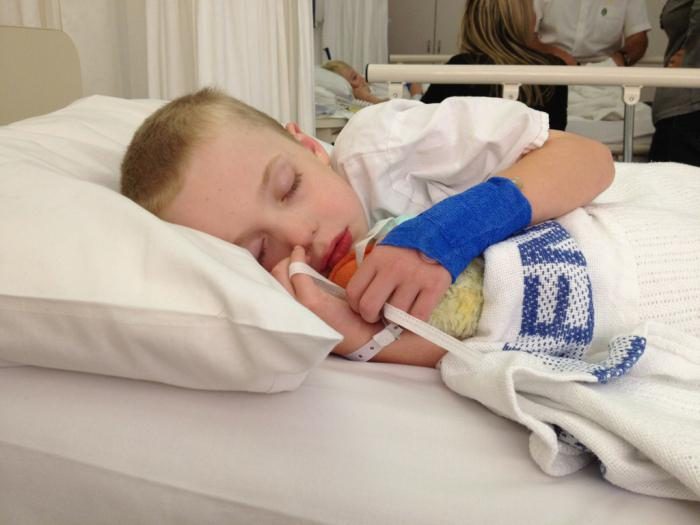
After tonsillectomy, the patient lies on the side.
Important: Complete recovery after tonsillectomy is equal to the epithelism of almond niches. It happens on 17 - 21 days after surgery. Then the postoperative period ends.
How much is the temperature after tonsillectomy?
On the second after the tonsilctomy day, the temperature of the patient can rise to subfebrile. Usually, it is 37 - 37.5 degrees. This increase is associated with the healing of the postoperative wound.
- Subfebrile, normally, keeps 7-10 days. But there are cases when the temperature is not normalized to complete epithelialization.
- If the temperature does not fall 3 weeks after surgery and longer, it is a reason to consult a doctor and pass the blood test. Perhaps some complications arose.

After tonsillectomy, the temperature can hold on to 21 days.
How much throat hurts after tonsillectomy?
Soreness in the throat after removing the GRAND occurs immediately either the next day. She can give in ears.
The most intense feelings of pain up to 6 days after surgery. By the second week, the almond niches are completely cleaned from the plaque, and by the end of the third week completely covered with a new epithelium. By this time, as a rule, soreness passes.

The pain in the throat is a feature of the postoperative period after tonsillectomy.
Bleeding after tonsiltectomy
Bleedings are most often found in patients after removing a sound scalpel. It opens in 1-8% of adults and 3-6% of children, and, as a rule, is associated with:
- errors in the operation
- features of the structure of blood vessels
- bad blood coagulation
Usually, the complication of this species occurs immediately after the tonsillectomy. It is dangerous for two main reasons that are:
- blood loss
- the risk to choke blood (especially, in children)
Doctors decide what measures to take to stop the bleeding and restore the blood of the patient, based on the severity of its condition.
IMPORTANT: a week after surgery, the patient may have blood from the healing almonds healing nichels in small quantities. Most likely, this bleeding is associated with mechanical damage to the mucous during food intake.
VIDEO: What will happen if removed Glands?
Complications after tonsilctomy
For other complications after removal, GRAND refers:
- inflammation due to the infection
- scars in the sky and sky
- hyperplasia naso-cell and paternal tonsil
- acetonemia in children
- faringitis and throat pain
These complications are extremely rare, provided that tonsonyctomy has been carried out according to indications and with adequate preoperative preparation.
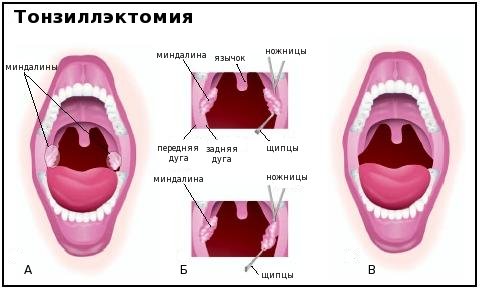
Tonsillectomy: before and after.
The consequences of tonsillectomy. Is it possible after tonsillectomy?
The positive consequence of the removal of GRAND is to get rid of chronic tonsillitis, frequent diseases of the angns. It turns out if you remove the skynote almonds, the angino will not? In general understanding, yes.
But immediately after surgery, it is possible a complication that doctors call "postoperative angina". It is manifested by pharyngitis (inflammation of the throat mucosa), inflammation of the sky, as well as lymphadenitis.
The negative consequence of tonsilctomy many specialists see the absence of a barrier between the environment and the human respiration bodies whose role was played by Gladda.
According to statistics, people after tonsillectomy bronchitis as a complication of ARVI occurs more often.
Restoration after tonsilectomy - rehabilitation. Meals after tonsilectomy: diet
In the first hours after the operation, until blood is distinguished from the RAS, the patient is recommended to lie on the side. When bleeding is stopped, you can turn over and get up. If there are no complications, you can return to everyday life immediately after discharge from the hospital.
Sometimes after surgery, therapy needs:
- antibiotics (if an infectious complication arose)
- antipires (if the temperature rose above 38-38.5 degrees)
- anesthetic drugs (especially in children, if the throat pain is very intense)
All days of the postoperative period recommended diet.
- On the first day there is not recommended at all.
- In the first 6 days, food should be liquid, homogeneous, room temperature.
- All 21 days can not be too hot, too cold, sharp, sour, all that can irritate the mucous membrane of the oral cavity and throat.
- You need to drink a daily rate: 1.5 liters for children, 2-3 l for adults.

In the first week after removal, Gand is recommended to eat liquid homogeneous food.
Tonsillectomy under general anesthesia: reviews
General anesthesia today is not the one that was 10 or 20 years ago. It is not toxic, does not threaten complications, it looks like the usual night's sleep.
IMPORTANT: Many believe that stress when surgery with general anesthesia is much more harmful than the anesthesia is common.
But what people say who survived common anesthesia when removing tonsils:
- Sveta: "Almonds removed me under general anesthesia. What to say came to myself very hard, the whole day is not in adequate. "
- Irina: "Two years ago, made tonsillectomy with general anesthesia. Made a injection in the ward, from which he swam in front of his eyes. They took to the operating room, put the dropper and dressed the mask. There was nothing nor hallucinations, nor the feeling of falling. There was no waste either, just wanted to sleep. But after the anesthesia passed, felt the pain in the throat in all colors. "
- Peter: "A wife, whom Gladda removed in childhood under local anesthesia, very brightly described me all his terrible feelings. Therefore, when the doctor advised me to resolve from chronic tonsillitis quickly, I chose a general anesthesia immediately. And did not regret. Everything went smoothly, anesthesiologist was good. "
